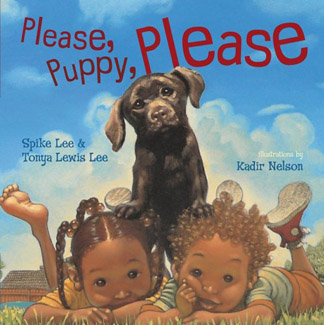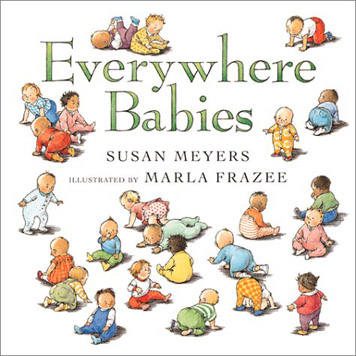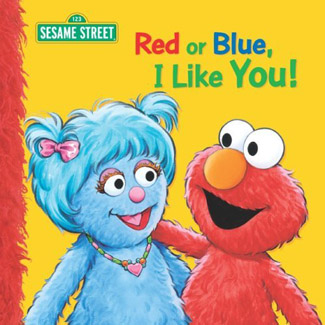Ephelba asked if I planned to review books on The Multicultural Toybox. The short answer: yes! My toddler’s collection of books mostly features animals (which, yes, I know can be racialized in disturbing and subtle ways, and perhaps I’ll write about that later), but there are a couple of fabulous books I read him frequently that I wanted to feature because they’re relevant to this site’s theme. I’ll head to the library soon to scout out some more promising children’s books that feature people of color and/or lessons about culture, or you can recommend some to me in the comments (hint, hint!).
First up: Spike Lee and Tonya Lewis Lee’s book Please, Puppy, Please. I was suckered into buying this book because of the illustrations by the ultra-talented Kadir Nelson. Rich, detailed, and evocative, the illustrations depict two young children who grow increasingly frustrated with the antics of their puppy. (Check out this wonderful photo of the Lees presenting the book to kids at a reading.)
The book has received much praise elsewhere for its depictions of the children and the puppy, but what most interested me was the archtypically suburban setting for the action. In popular culture and in children’s programming such as Sesame Street (as well as in everyday life), African Americans are so frequently associated with urban settings that I found refreshing the African American children’s frolicking through their decidedly middle-class suburb, with its large yards, generous blue sky, trimmed green lawns, telephone poles and lines, fenced backyards, well-maintained homes, and meticulous border gardens planted with calla lilies.
Less engaging is the text, which consists largely of variations on “Please, Puppy, Puppy, please!” That gets old quickly, even with varying intonation. Still, the illustrations make up, in my opinion, for the lack of interesting text.
Everywhere Babies is one of my absolute favorite children’s books. Each page features a new set of actions or a new stage of development for babies; the book covers the first year of an infant’s life. My favorite page spread features a sidewalk scene in which more than 30 people—including babies—interact. The page features friendships and families of all kinds, including what could be interpreted as gay and straight couples, as well as multiracial families. The illustrations, by Marla Frazee, who illustrated one of my other favorite children’s books, Woody Guthrie’s New Baby Train
, are lovely, and in the case of this page spread accompany the lyrical text, “Everyday, everywhere, babies are carried–in backpacks, in front packs, in slings, and in strollers / in car seats, and bike seats, and on Daddy’s shoulders.” Everywhere Babies is a must-have for any multicultural, queer-friendly home library.
Red or Blue, I Like You! features red monster Elmo and his new friend Angela, a blue monster. Before reading the book, I was worried it was going to be heavy-handed, with a didactic message about how although we look different on the outside, we’re all the same inside. But no–the book transcends that cliché, focusing in on how we shouldn’t make assumptions about the habits and tastes of people from other cultures, nor should we fear unfamiliar cultures, but rather meet people (or monsters) quite literally where they live. But the book also offers parents plenty of opportunities to have conversations with their children about their own neighborhoods. For example, when Elmo visits Angela’s house in hwe homogeneous neighborhood, he asks, “How come all the monsters in your neighborhood are blue? Where are all the different-colored monsters we have on Sesame Street?” Angela shrugs and says she doesn’t know. Once inside Angela’s house, her brother and his blue friends ask Elmo if he wants to watch the TV show Supermonster with them. When Elmo says he’d rather play with Angela’s train set (go Train Girl!), her brother replies, “I thought all red monsters loved that show!” Both young monsters learn that they enjoy each other’s cuisine, as well as like the same activities.
Elmo is clearly made uneasy by the homogeneity of Angela’s neighborhood, so it’s no surprise that Angela is taken aback by the incredible diversity of Sesame Street’s denizens. But she soon learns to welcome this diversity, joining her new friends in welcoming a mixed-monster (red mom, blue dad) family to Sesame Street. Overall, the book presents a nice tale that offers plenty of points for discussion of perceived cultural differences and neighborhood diversity.
What are your favorite multicultural (or otherwise diversity-themed) books for young ones?



I love One Dad, Two Dads, Brown Dads, Blue Dads, by Johnny Valentine. In addition to brown and peach-colored dads, it also features same-sex and single-parent (single-fathered) familes. The great part is that the featured couple are indeed two dads, but the primary difference presented is their blue color, not their gender. It’s quite a charming book.